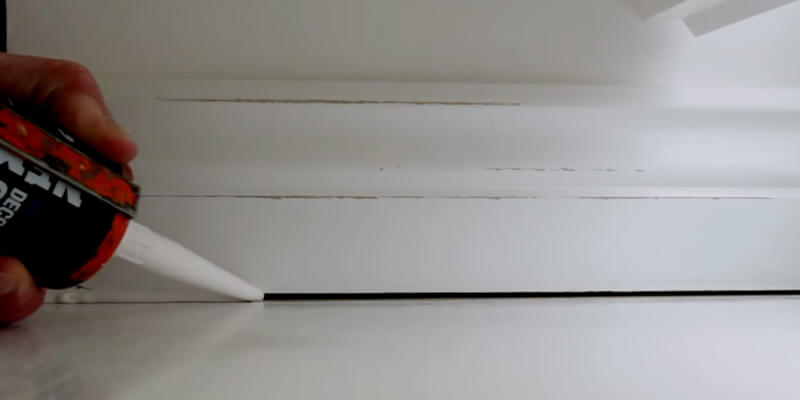Out of frustration, you might ask, why does my caulk keep cracking? You’re not alone who are facing the same problem. Tons of people are eager to know the solution. As a result, today, we will go over these reasons and offer solutions.
Finding out the cracking reason can save you a lot of money and hassle.
Many have applied the solutions and got impressive results on their caulk joints, which is why you must find out the real cause.
Let’s start with the list of the reasons which would be the most probable cause for caulk cracks.
List of Reasons Why Caulk Gets Keep Cracking
You have several reasons why your caulk keeps cracking. Getting into knowing these causes would let you avoid them in the future. Let’s review these in detail, which might explain your ever-cracking caulk.
Reason 1: Using a Lot Lesser Caulk
Among all the reasons, the common mistake is to use a lot less caulk for your task. Lesser caulk means not enough elements to create a robust grip on the surface. In addition, you must make sure you are using the caulk before it gets cured because the caulk shrinks after it’s cured.
Plus, the surface gets minimal caulk when you move your caulk roller or squeezer super fast. As a result, you don’t have enough caulk to create a solid joint. So be steady when you are rolling your squeezer onto a specific surface.
Reason 2: Not Removing Older Caulks
Most often or not, older caulk starts providing unnecessary cracks within the joint. First, you must check out the date you have applied the caulk. It’s most likely that the expiry date is over, and you must caulk the joint again. Plus, when applying new caulk, be sure to remove the older caulks.
Many of us make mistakes when re-caulking the joint. We forgot to remove all parts of the older caulk. It’s a fact that older caulk can also affect the efficiency of your new caulks. When working with older caulks, remove them and make a clean start.
Reason 3: The Surface Was Not Clean Enough
One of the reasons why your caulk keeps cracking is a messier surface. As discussed before, a good caulking joint needs a cleaner surface. If the following surface contains dirt or power, the joint would likely get cracks sooner or later.
Plus, a bad pain that is powdery can cause cracks on the caulk. Therefore, the surface needs proper cleanup and pre-check for proper adhesion. Without proper adhesion, the caulk will not work as you expect it to, so our advice is to clean up your surface beforehand.
Reason 4: Wrong Caulking Process
You may not be using the right caulking process, causing you regular cracks. Hence, you could use an insulator like a backer rod. This type of insulator prevents future cracks and better prepares the surface.
Reviewing your previous cracking process is the best when you are getting cracks too often. Hence, you must follow the latest caulking process and determine the required steps to take. Then, take all the measures which might seem suspicious to you and change the process next time.
Reason 5: Insufficient Gap in Between
The insufficient gaps between two objects might create unwanted cracks. You must check out the gap you are applying caulk into. It might feature a wider gap which is not good for applying caulk. You must add some elements to minimize the gap so the caulk can retain its place. Hence, it’s one of the reasons why shower caulk keeps cracking.
We have seen many users applying the caulk in the wrong amount of gaps. It stands true even if you have a narrow space between the objects. You must at least have 2/8 of an inch to create a cohesive caulk joint.
Reason 6: Insects Attack
When your caulk has a hole within, the insects start attacking it. Many of us discovered that secrets such as ants attack our caulk and make it hollow from inside. It gets worse when you live in areas where the insects are at their peak.
As a solution, you might want to go for the caulks, which prevent insect attacks. As a result, you get total peace of mind as you don’t have to think about reapplying caulk. Hence, look at the caulk if you notice any insect activity around your caulk.
Reason 7: Unexpected Surface Movement
It might be that the area you have called has higher movement. For example, if you have applied caulk to the areas near the door, the caulk will get constant service movement. As a result of regular tension on the surface, getting cracks on the caulk is more evident.
Check if the wall, ceiling, or floor gets any movement. If it does get surface movement, try to fix it out or go for the ones that are more suitable for movement. Hence, it’s the reason most professionals advise you to think before applying caulk.
How To Stop Caulk Cracking
You could follow some steps to avoid any caulking cracks. However, obeying these rules would provide you with the best solution to your caulking cracks. Let’s take a look at these solutions:
- Use the Right Caulk: You must be aware that you have several options for caulking type. You must use the right caulk type for your task. For example, if your caulking around the tub keeps cracking, you probably used the wrong type of caulk.
- Clean up the Surface: Many don’t perfectly prepare the surface. Cleaning up the surface beforehand ensures you don’t get any cracks on the caulk. Better surfaces would lead to better results in your future caulking.
- Avoid Applying Too Much: You get the message that you don’t need to apply a lot of caulks. Applying excessive caulk would eventually lead to further problems. Hence, you need to maintain a consistent line when using the caulking gun.
Tips on Removing Existing Caulk
Need to create new caulking? You need to remove the existing one first. Below are the steps you must go through to get an effective caulk removal.
Step 1: The first step of the removal process is to soften the caulk as much as possible.
Step 2: Now, use any slicer or knife to remove the caulk. Make sure you scrape off the remaining, which doesn’t stick out while not damaging the surface.
Step 3: In the following step, clean the surface so you can apply a new caulk again.
FAQ
Here are some of the questions you might ask about regular caulk cracking.
Why does caulking crack after drying?
Does silicone sealant crack?
Why does caulking crack in winter?
Conclusion
Once you read through our guides, you won’t have any questions about why my caulk keeps cracking.
Moreover, you should find out the reason and fix it right away to make you more prepared for it next time.
As we talk through the steps to prevent future cracking, make sure you follow each point.
Preventing future caulk cracks would save you tons of money and time. As a last piece of advice, don’t sit idle; find the real cause of cracks and get ahead.
Want to Learn More:
- How To Prevent Mold In Shower Caulk: 4 Ways Of Prevention
- 10 Best Caulk For Baseboards In 2022 (Top Picks & Reviews)
- Is Landlord Responsible For Caulking (Assumption Or Fact)
- How To Remove Wet Silicone Caulk – 5 Easiest Steps To Doing It
Hello! this is John Cox. If I’m not wrong, you love Home. Right? And you already met one of them who’ve been in this field since 2005 and still go on. According to my interest, I’ve started this blog to share my thoughts about Home sectors, and you’ll love it.


